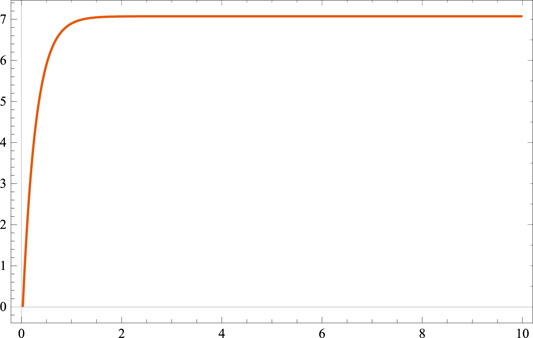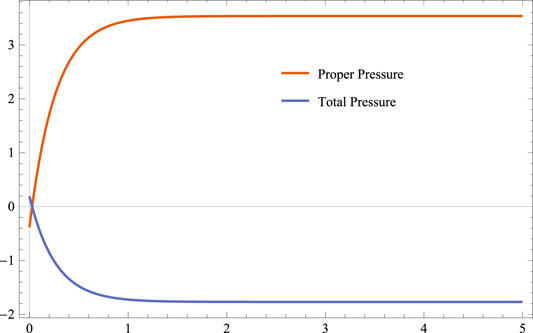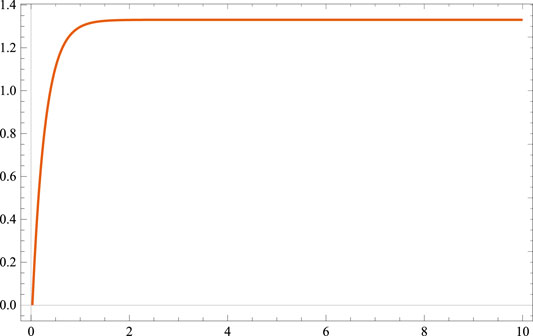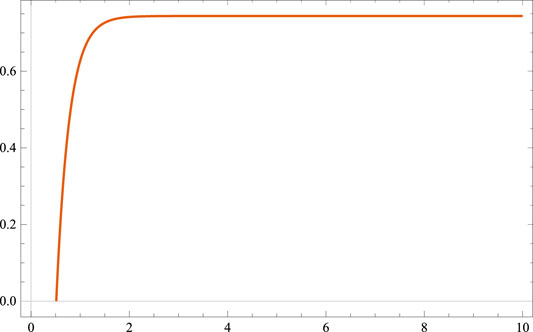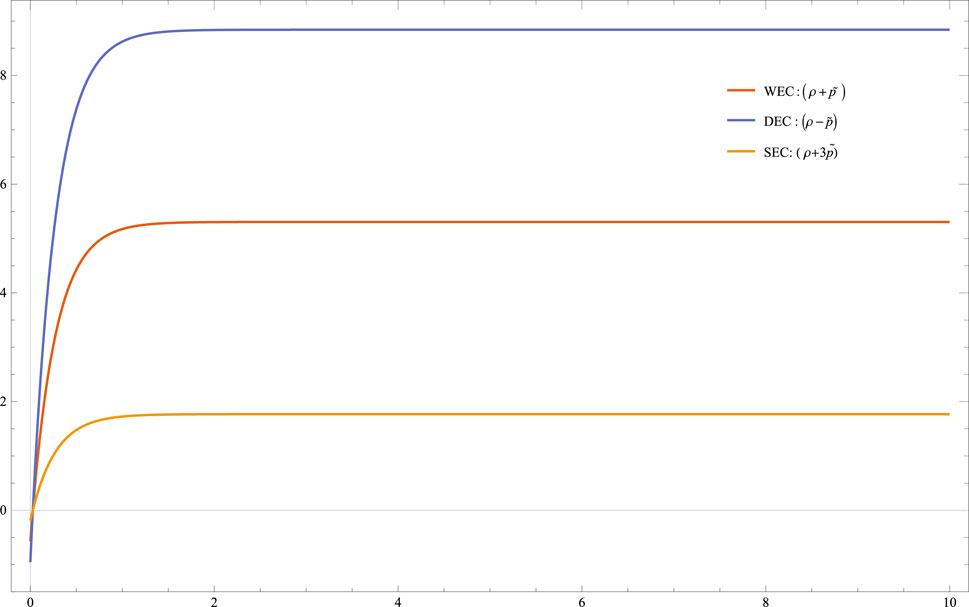- Department of Mathematical Sciences, Bodoland University, Kokrajhar, India
This paper deals with the bulk viscous Bianchi type-V cosmological model with an exponential scale factor in Lyra geometry based on f(R, T) gravity, by considering a time dependent displacement field. To determine the nature and physical properties of the model, we considered Harko et al. (Harko et al., Phys. Rev. D, 2011, 84, 024020) [proposed the linear form f(R, T) = f1(R) + f2(T)], in which the barotropic equation of state for pressure, density, and bulk viscous pressure is proportional to energy density. The kinematical properties of the model are also discussed in the presence of bulk viscosity. Evolution of energy conditions is also studied and examined the behaviour of that in examined in order to explain the late-time cosmic acceleration.
1 Introduction
As evidenced by various observational data from Garnavich (Garnavich et al., 1998a; Garnavich et al., 1998b), Riess (Riess et al., 1998) and Perlmutter (Perlmutter et al., 1997; Perlmutter et al., 1999) the expansion of the universe is accelerating. The cause of this observed acceleration is still unknown, and the “dark energy” problem is commonly used to describe it. Two methods have been proposed to overcome this problem, one is to develop several dark energy candidates and the other is to modify Einstein’s theory of gravitation. It is very exclusively well known that modification of Einstein’s theory plays an important role in explaining the late time acceleration and negative pressure. Among these modifications of Einstein’s theories are Brans Dicke (BD) theory, f(R) gravity: Carroll (Carroll et al., 2004), Nojiri (Nojiri and Odintsov, 2007), Bertolami (Bertolami et al., 2007), Capozziello (Capozziello et al., 2008), Sotiriou (Sotiriou and Faraoni, 2010), Capozziello (Capozziello and Vignolo, 2010), Iosifidis (Iosifidis et al., 2019), Gogoi (Gogoi and Dev Goswami, 2020), f(T) gravity: Yang (Yang, 2011), Tamanini (Tamanini and Böhmer, 2012), Paliathanasis (Paliathanasis et al., 2016), Bamba (Bamba et al., 2017a), Ferraro (Ferraro and Guzmán, 2018), Bahamonde (Bahamonde et al., 2019), f(G) gravity: De Felice (De Felice and Tsujikawa, 2009), Abbas (Abbas et al., 2015), Bamba (Bamba et al., 2017b), Sharif (Sharif and Saba, 2018), and f (R, T) gravity: De Felice (De Felice et al., 2011), De Laurentis (De Laurentis and Lopez-Revelles, 2014), De Laurentis (De Laurentis et al., 2015), Odintsov (Odintsov et al., 2019), where R, T, and G indicate the scalar curvature, the torsion scalar, and the Gauss Bonnet scalar respectively. But in a recent cosmological model, f(R) gravity has become a more attractive theory to represent the behaviour of the expansion of the universe, known as f(R, T) gravity, where the matter Lagrangian is given by an arbitrary function of the Ricci scalar R and the trace of the energy momentum tensor T. Recently, Rao (Rao and Papa Rao, 2015), Kanakavalli (Kanakavalli et al., 2016), Sahoo (Sahoo et al., 2017), Nath (Nath and Sahu, 2019), and Sharma (Sharma et al., 2019), investigated the nature of the universe in f(R, T) gravity in different cosmological models in various space times. Very recently, Arora (Arora et al., 2021) discussed the late-time viscous cosmology in f(R, T) gravity considering a bulk viscous fluid with viscosity coefficient.
Bulk viscosity is particularly essential in current cosmology, because it plays a key role in the inflationary expansion. Misner (Misner, 1968) has mentioned that when neutrinos disconnect from the viscosity of the cosmic fluid, an effective process of entropy production may emerge during cosmic evolution. Barrow (Barrow, 1986) and Padmanabhan (Padmanabhan and Chitre, 1987) have pointed out that in the FRW space time, the presence of bulk viscosity causes inflationary solutions. Subsequently, Johri (Johri and Sudharsan, 1989)have studied the inflationary solutions in the presence of bulk viscosity in the Brans Dicke theory. The presence of bulk viscosity institutes a number of intriguing characteristics to the universe’s dynamics. It was once thought that neutrino viscosity may smooth out primordial anisotropies, resulting in the isotropic universe we see today. The big-bang singularity can also be avoided if bulk viscosity is present. A phenomenological process of particle production in a strong gravitational field can also be explained by bulk viscosity. A bulk viscous fluid can be used to represent the back-reaction consequences of string formation. The bulk viscosity cosmological models have been discussed, and the model’s nature has been discussed by Fabris (Fabris et al., 2006), Singh (Singh and Baghel, 2009), Yadav (Yadav and Yadav, 2011), Singh (Bali et al., 2012), Kiran (Kiran and Reddy, 2013), Mahanta (Mahanta, 2014), Rao (Bhaskara Rao et al., 2015), Tiwari (Tiwari and Tiwari, 2017), and Sahoo (Sahoo and Reddy, 2018). Very recently Goswami (Goswami et al., 2021) and Kotambkar (Kotambkar et al., 2021) have investigated the modeling of accelerating and the dynamical behaviours of Chaplygin gas, cosmological and gravitational “constants” with cosmic viscous fluid in different contexts.
The expansion of the universe, which is considered to be due to large scale recession of galaxies, was uknown during that period, and for that reason Einstein had to include the cosmological constant into the field equations when discussing cosmological solutions. Not only has the theory proved successful in describing gravitational phenomena, but it has also served as the foundation for cosmological models of the universe. Classical physics does not, however, describe gravity as the only force. Electromagnetic forces are also important, and they are not explained as geometric phenomena by general relativity. Many attempts to unify electromagnetic and gravitation have been made. Weyl proposed a modified Riemannian geometry theory to unify electromagnetic and gravitation in 1918. However, due to the non-integrability of length transfer, this hypothesis was later dismissed. By inserting a gauge function into the structureless manifold and removing the non-integrability of length transfer, G. Lyra (Lyra, 1951) introduced a new sort of alternative theory. Sen (Sen, 1957); Sen (Sen and Dunn, 1971) suggested a scalar-tensor theory of gravity based on this theory, which was an analogue of the Einstein field equations. Later, Halford (Halford, 1972)concluded that the constant displacement vector used in Lyra’s geometry acts as a cosmological constant in the typical general relativistic interpretation. Within observational constraints, the scalar-tensor theory based on Lyra’s geometry predicts the same result as the Einstein theory. Subsequently, Soleng (Soleng, 1987) looked into cosmological models based on Lyra geometry and discovered that the displacement field contains either a creation field equal to a specific vacuum field that can be regarded as a cosmological term when combined with a gauge vector. A lot of authors have looked into cosmological theories based on Lyra geometry as Pradhan (Pradhan and Vishwakarma, 2004), Singh (Singh, 2008), Singh (Singh and Kale, 2009), Ram (Ram et al., 2010), Adhav (Adhav, 2011), Kumari (Kumari et al., 2013), Singh (Singh and Rani, 2015), Maurya (Maurya and Zia, 2019), Ram (Ram et al., 2020), Hegazy (Hegazy, 2020), where they have investigated the different nature of the model in different cosmological models so far. Recently Brahma (Brahma and Dewri, 2021)has investigated the f(R, T) gravity for Bianchi type–V metric in Lyra geometry and to get the deterministic solution of the model one special form of Harko et al. (2011) is used with linearly varying deceleration parameter to investigate the myterious nature of the dark energy. Here, in this study we are interested in Bianchi type-v cosmological model, because it describes homogeneous and anisotropic universes with various scale factors along each spatial direction, which is a natural generalisation of the FRW model of the universe. The above exclusive analysis and investigation encourage us to study the Bianchi type V cosmological model with f(R, T) gravity in the presence of viscous fluid based on Lyra geometry.
2 Overview and the Field Equations of f(R, T) Gravity
Here we consider Bianchi type -V space time in the following form
where A, B, C are functions of cosmic time t and m is a constant.
The action of f(R, T) gravity, where we have obtained the various field equations and modification of f(R, T) gravity with observational constraints in Lyra geometry by Harko et al.(Harko et al., 2011) [Taking G = 1] as
where
In which
such that its trace is given by T = gijTij
Consider that the matter Lagrangian Lm depends only on the metric tensor components gij and does not depend on its derivatives, thus it reduces to
Now by varying the action S in Eq. 2 with respect to metric tensor gij, the gravitational field equations of
where
Here
If the matter is considered as a perfect fluid, then the stress energy tensor of the matter Lagrangian is given by
Here ρ denotes the energy density and ui = (0, 0, 0, 1) is the four velocity vector in the co-moving co-ordinate system satisfying the condition uiui = − 1 and ui∇jui = 0. Since there is no unique choice for matter Lagrangian, we assume a perfect fluid matter as
As we know that the physical nature of the matter field depends on the metric tensor Θij for the field equations of
But, in this paper the second case is considered to describe the behaviour of the model in
where
Now, using Eq. 11 in Eq. 6, we obtain
The field equations of
Applying Eq. 3 in Eq. 13, we obtain the field equations in Lyra geometry [Maurya (Maurya, 2020)] as given by
Here the displacement vector field is
For the metric (1), the Einstein field Equation 14 reduces to the form as
3 Solutions of the Field Equations
The spatial volume (V) and the scale factor a(t) are given by
The generalized Hubble’s parameter (H) and the scalar expansion (θ) are defined as
where
Integrating Eq. 19, we get
where k1 is an integrating constant and without loss of generality, the constant of integration k1 can be chosen as unity as
In the field Equations 15–19, we found that there are five equations involving seven unknowns. As the field equations are highly non-linear differential equations, we need some other condition to complete the field equations such as.
• we consider the shear scalar (σ) is proportional to the expansion scalar (θ) [Collins et al. (Collins et al., 1980)]
where n is a non zero constant.
• Let us consider the combined effect of the proper pressure and the bulk viscous pressure, for a barotropic fluid can be expressed as follows:
Such that ɛ = ɛ0 − η(0 ≤ ɛ0 ≤ 1) and ϵ, ɛ0, and η are constant. The symbols ξ and p are respectively known as the coefficient of bulk viscosity and proper pressure of the model.
Let us consider a time dependent displacement field scale factor [ Pradhan et al. (Pradhan et al., 2006)] as given by
where α and α1 are constants.
From Eqs 23, 24, 26, we get the metric potentials of the model which are
Then Eq. 1 reduces to
4 Physical Properties of the Model in f(R, T) Gravity
The Physical Parameters of the model are obtained as follows:
Spatial Volume:
Hubble’s Parameter:
The Expansion Scalar:
The Shear Scalar:
Anisotropy parameter:
Deceleration parameter:
Adding Eqs 15–17 and applying in Eq. 18, we have the energy density given by
Also the total pressure, proper pressure, the co-efficient of bulk viscosity and the displacement vector are given by
The Trace
where
From Eqs 28, 31, we obtain the statefinder parameters, which is defined as
Energy Conditions
The energy conditions are constructed from the Raychaudhuri equation, which are very important tools to describe the behavior of the compatibility of timelike, lightlike, or spacelike curves and singularities. Very recently Alvarenga (Alvarenga et al., 2013), Moraes (Moraes and Sahoo, 2017), Zubair (Zubair et al., 2018), and Ahmed (Ahmed and Abbas, 2020) have tested the energy conditions in f (R, T) theory of gravity and to check the energy conditions for the present model, they defined the weak energy conditions (WECs), dominant energy conditions (DECs), and the strong energy conditions (SEC) as given by
1) ρ ≥ 0, ρ + p ≥ 0 2) ρ − p ≥ 0 (iii)ρ + 3p ≥ 0
To observe the absolute observational data, we have plotted the graphs for energy conditions in terms of ρ and
5 Conclusion
In this study, a completely spatially homogeneous and anisotropic Bianchi type-V cosmological model has been discussed in the presence of a bulk viscous fluid based on Lyra geometry, with an exponential form of scale factor. We employed a barotropic equation of state for pressure and energy density to determine the nature and deterministic solution of the highly non linear differential equation. Furthermore, we assumed that bulk viscous pressure is proportional to energy density [Naidu et al. (Naidu et al., 2013)]. As per recent observational data in combination with Baryonic Acoustic Oscillations (BAO), Cosmic Microwave Background (CMB), from Type Ia Supernova (SN Ia), the model found in this paper is in conformative. The model 28) found here is shearing, expanding, and anisotropic which is similar to [Zia (Zia et al., 2018), Tiwari (Tiwari et al., 2020), and Desikan (Desikan, 2020)]. At t = 0, we found that the model has no singularity. Subsequently, we can see from Eqs 30, 31 that the Hubble’s parameter (H) and the expansion scalar remain constant throughout the expansion, implying that model 28) represents a uniform expansion. It is evident from Eq. 29 that the volume (V) of the universe rises with cosmic time (t), and that as V approaches infinity, for t → ∞. We observed from Eq. 38 that the bulk viscosity coefficient increases with time and approaches infinity as t approaches infinity. The model’s energy density, total pressure, coefficient of bulk viscosity, and displacement vector all rise positively, but they all yield a constant value for t tending to infinity (Figures 1–4). The model predicts an accelerating phase of the universe for q = − 1, which is given by Eq. 34. In the current model of the universe, there is a dark energy due to negative pressure in the presence of bulk viscous fluid based on Lyra geometry with f (R, T) gravity, as shown in Figure 2. All the three energy conditions are satisfied as in Figure 5. The Trace and the Ricci scalar are always positive throughout the cosmic time t, and for t → ∞, it offers a constant value, as shown in Eqs 40, 41. Furthermore, r and s tend to 1 and 0 respectively, indicating that the current universe model approaches the ΛCDM model. There have been many works done by researchers in the area of Lyra geometry, but Lyra geometry with f(R, T) gravity is a very new concept and there is scope for the continuation of work.
Data Availability Statement
The original contributions presented in the study are included in the article/Supplementary Material, further inquiries can be directed to the corresponding authors.
Author Contributions
All authors listed have made a substantial, direct, and intellectual contribution to the work and approved it for publication.
Conflict of Interest
The authors declare that the research was conducted in the absence of any commercial or financial relationships that could be construed as a potential conflict of interest.
Publisher’s Note
All claims expressed in this article are solely those of the authors and do not necessarily represent those of their affiliated organizations, or those of the publisher, the editors and the reviewers. Any product that may be evaluated in this article, orclaim that may be made by its manufacturer, is not guaranteed or endorsed by the publisher.
References
Abbas, G., Momeni, D., Aamir Ali, M., Myrzakulov, R., and Qaisar, S. (2015). Anisotropic Compact Stars in F(G) Gravity. Astrophys. Space Sci. 357, 1–11. doi:10.1007/s10509-015-2392-6
Adhav, K. S. (2011). LRS Bianchi Type-I Universe with Anisotropic Dark Energy in Lyra Geometry. Int. J. Astron. Astrophysics 01, 204–209. doi:10.4236/ijaa.2011.14026
Ahmed, R., and Abbas, G. (2020). Non-adiabatic Gravitational Collapse in f(R,T) Gravity with Karmarkar Condition for Anisotropic Fluid. Mod. Phys. Lett. A. 35, 2050103. doi:10.1142/S0217732320501035
Alvarenga, F. G., Houndjo, M. J. S., Monwanou, A. V., and Orou, J. B. C. (2013). Testing Some f(R,T) Gravity Models from Energy Conditions. Jmp 04, 130–139. doi:10.4236/jmp.2013.41019
Arora, S., Bhattacharjee, S., and Sahoo, P. K. (2021). Late-time Viscous Cosmology in f(R, T) Gravity. New Astron. 82, 101452. doi:10.1016/j.newast.2020.101452
Bahamonde, S., Flathmann, K., and Pfeifer, C. (2019). Photon Sphere and Perihelion Shift in Weak F(T) Gravity. Phys. Rev. D 100 (8), 084064. doi:10.1103/PhysRevD.100.084064
Bali, R., Singh, P., and Singh, J. P. (2012). Bianchi Type V Viscous Fluid Cosmological Models in Presence of Decaying Vacuum Energy. Astrophys. Space Sci. 341, 701–706. doi:10.1007/s10509-012-1134-2
Bamba, K., Ilyas, M., Bhatti, M. Z., and Yousaf, Z. (2017). Energy Conditions in Modified F(G) Gravity. Gen. Relativ. Gravit. 49, 1–17. doi:10.1007/s10714-017-2276-x
Bamba, K., Odintsov, S. D., and Saridakis, E. N. (2017). Inflationary Cosmology in Unimodular F(T) Gravity. Mod. Phys. Lett. A. 32, 1750114. doi:10.1142/S0217732317501140
Barrow, J. D. (1986). The deflationary universe: an instability of the de Sitter universe. Phys. Lett. B 180, 335–339. doi:10.1016/0370-2693(86)91198-6
Bertolami, O., Böhmer, C. G., Harko, T., and Lobo, F. S. N. (2007). Extra Force inf(R)modified Theories of Gravity. Phys. Rev. D 75, 104016. doi:10.1103/PhysRevD.75.104016
Bhaskara Rao, M. P. V. V., Reddy, D. R. K., and Sobhan Babu, K. (2015). Bianchi Type-V Bulk Viscous String Cosmological Model in a Self-Creation Theory of Gravitation. Astrophys. Space Sci. 359, 1–5. doi:10.1007/s10509-015-2501-6
Brahma, B. P., and Dewri, M. (2021). Bianchi Type-V Modified f(R,T) Gravity Model in Lyra Geometry with Varying Deceleration Parameter. J. Math. Comput. Sci. 11, 1018–1028. doi:10.28919/jmcs/5281
Capozziello, S., Cardone, V. F., and Salzano, V. (2008). Cosmography off(R)gravity. Phys. Rev. D 78, 063504. doi:10.1103/PhysRevD.78.063504
Capozziello, S., and Vignolo, S. (2010). Metric-affine F(R)-gravity with Torsion: an Overview. Ann. Phys. 19 (3-5), 238–248. doi:10.1002/andp.201010420
Carroll, S. M., Duvvuri, V., Trodden, M., and Turner, M. S. (2004). Is Cosmic Speed-Up Due to New Gravitational Physics? Phys. Rev. D 70, 043528. doi:10.1103/PhysRevD.70.043528
Collins, C. B., Glass, E. N., and Wilkinson, D. A. (1980). Exact Spatially Homogeneous Cosmologies. Gen. Relat. Gravit. 12, 805–823. doi:10.1007/BF00763057
De Felice, A., Suyama, T., and Tanaka, T. (2011). Stability of Schwarzschild-like Solutions inf(R,G)gravity Models. Phys. Rev. D 83 (10), 104035. doi:10.1103/PhysRevD.83.104035
De Felice, A., and Tsujikawa, S. (2009). Construction of Cosmologically Viable Gravity Models. Phys. Lett. B 675, 1–8. doi:10.1016/j.physletb.2009.03.060
De Laurentis, M., and Lopez-Revelles, A. J. (2014). Newtonian, Post-Newtonian and Parametrized Post-Newtonian Limits of f(R, G) Gravity. Int. J. Geom. Methods Mod. Phys. 11, 1450082. doi:10.1142/S0219887814500820
De Laurentis, M., Paolella, M., and Capozziello, S. (2015). Cosmological Inflation in F(R,G) Gravity. Phys. Rev. D 91, 083531. doi:10.1103/PhysRevD.91.083531
Debnath, P. S. (2019). Bulk Viscous Cosmological Model in f(R,T) Theory of Gravity. Int. J. Geom. Methods Mod. Phys. 16, 1950005. doi:10.1142/S0219887819500051
Desikan, K. (2020). Cosmological Models in Lyra Geometry with Time-Varying Displacement Field. Afr. Rev. Phys. 15, 32.
Fabris, J. C., Gonçalves, S. V. B., and Ribeiro, R. d. S. (2006). Bulk Viscosity Driving the Acceleration of the Universe. Gen. Relativ. Gravit. 38, 495–506. doi:10.1007/s10714-006-0236-y
Ferraro, R., and Guzmán, M. J. (2018). Quest for the Extra Degree of freedom in F(T) Gravity. Phys. Rev. D 98, 124037. doi:10.1103/PhysRevD.98.124037
Garnavich, P. M., Jha, S., Challis, P., Clocchiatti, A., Diercks, A., Filippenko, A. V., et al. (1998). Supernova Limits on the Cosmic Equation of State. Astrophysical J. 509, 74–79. doi:10.1086/306495
Garnavich, P. M., Kirshner, R. P., Challis, P., Tonry, J., Gilliland, R. L., Smith, R. C., et al. (1998). Constraints on Cosmological Models from [ITAL]Hubble Space Telescope[/ITAL] Observations of High-[CLC][ITAL]z[/ITAL][/CLC] Supernovae. Astrophysical J. Lett. 493, L53–L57. doi:10.1086/311140
Gogoi, D. J., and Dev Goswami, U. (2020). A New F(R) Gravity Model and Properties of Gravitational Waves in it. Eur. Phys. J. C 80, 1–21. doi:10.1140/epjc/s10052-020-08684-3
Goswami, G. K., Yadav, A. K., Mishra, B., and Tripathy, S. K. (2021). Modeling of Accelerating Universe with Bulk Viscous Fluid in Bianchi V Space‐Time. Fortschr. Phys. 69 (6), 2100007. doi:10.1002/prop.202100007
Halford, W. D. (1972). Scalar‐Tensor Theory of Gravitation in a Lyra Manifold. J. Math. Phys. 13 (11), 1699–1703. doi:10.1063/1.1665894
Harko, T., Lobo, F. S. N., Nojiri, S. I., and Odintsov, S. D. (2011). f(R,T)gravity. Phys. Rev. D 84, 024020. doi:10.1103/PhysRevD.84.024020
Hegazy, E. A. (2020). Bulk Viscous Bianchi Type I Cosmological Model in Lyra Geometry and in the General Theory of Relativity. Astrophys. Space Sci. 365, 1–8. doi:10.1007/s10509-020-03836-z
Iosifidis, D., Petkou, A. C., and Tsagas, C. G. (2019). Torsion/nonmetricity Duality in F(R) Gravity. Gen. Relativ. Gravit. 51, 1–15. doi:10.1007/s10714-019-2539-9
Johri, V., and Sudharsan, R. (1989). BD-FRW Cosmology with Bulk Viscosity. Aust. J. Phys. 42, 215–222. doi:10.1071/PH890215
Kanakavalli, T., Rao, G. A., and Reddy, D. R. K. (2016). Bianchi Type V Scalar Field Cosmological Models in f(R, T) Theory of Gravity. Prespacetime J. 7, 1722–1728.
Kiran, M., and Reddy, D. R. K. (2013). Non-existence of Bianchi Type-III Bulk Viscous String Cosmological Model in f(R,T) Gravity. Astrophys. Space Sci. 346, 521–524. doi:10.1007/s10509-013-1459-5
Kotambkar, S., Kelkar, R. K., and Singh, G. P. (2021). Dynamical Behaviours of Chaplygin Gas, Cosmological and Gravitational 'constants' with Cosmic Viscous Fluid in Bianchi Type V Space-Time Geometry. J. Phys. Conf. Ser. 1913 (1), 012103. doi:10.1088/1742-6596/1913/1/012103
Kumari, P., Singh, M. K., and Ram, S. (2013). Anisotropic Bianchi Type-III Bulk Viscous Fluid Universe in Lyra Geometry. Adv. Math. Phys. 2013, 1–5. doi:10.1155/2013/416294
Lyra, G. (1951). über eine Modifikation der Riemannschen Geometrie. Math. Z. 54, 52–64. doi:10.1007/BF01175135
Mahanta, K. L. (2014). Bulk Viscous Cosmological Models in f(R,T) Theory of Gravity. Astrophys. Space Sci. 353, 683–689. doi:10.1007/s10509-014-2040-6
Maurya, D. C. (2020). Modified f(R,T) Cosmology with Observational Constraints in Lyra's Geometry. Int. J. Geom. Methods Mod. Phys. 17, 2050001. doi:10.1142/S0219887820500012
Maurya, D. C., and Zia, R. (2019). Brans-Dicke Scalar Field Cosmological Model in Lyra's Geometry. Phys. Rev. D 100, 023503. doi:10.1103/PhysRevD.100.023503
Moraes, P. H. R. S., and Sahoo, P. K. (2017). The Simplest Non-minimal Matter-Geometry Coupling in the f(R, T) Cosmology. Eur. Phys. J. C 77, 1–8. doi:10.1140/epjc/s10052-017-5062-8
Naidu, R. L., Reddy, D. R. K., Ramprasad, T., and Ramana, K. V. (2013). Bianchi Type-V Bulk Viscous String Cosmological Model in f(R,T) Gravity. Astrophys Space Sci. 348, 247–252. doi:10.1007/s10509-013-1540-0
Nath, A., and Sahu, S. K. (2019). LRS Bianchi Type V Perfect Fluid Cosmological Model in f(R, T) Theory. Can. J. Phys. 97, 443–449. doi:10.1139/cjp-2018-0061
Nojiri, S. I., and Odintsov, S. D. (2007). eConf C0602061, 06. Int. J. Geom. Meth. Mod. Phys. 4 (115), 16.
Odintsov, S. D., Oikonomou, V. K., and Banerjee, S. (2019). Dynamics of Inflation and Dark Energy from F(R,G) Gravity. Nucl. Phys. B 938, 935–956. doi:10.1016/j.nuclphysb.2018.07.013
Padmanabhan, T., and Chitre, S. M. (1987). Viscous Universes. Phys. Lett. A. 120, 1–4. doi:10.1016/0375-9601(87)90104-6
Paliathanasis, A., Barrow, J. D., and Leach, P. G. L. (2016). Cosmological Solutions off(T)gravity. Phys. Rev. D 94, 023525. doi:10.1103/PhysRevD.94.023525
Perlmutter, S., Aldering, G., Goldhaber, G., Knop, R. A., Nugent, P., Castro, P. G., et al. (1999). Measurements of Ω and Λ from 42 High‐Redshift Supernovae. Astrophysical J. 517, 565–586. doi:10.1086/307221
Perlmutter, S., Gabi, S., Goldhaber, G., Goobar, A., Groom, D. E., Hook, I. M., et al. (1997). Measurements of the Cosmological Parameters Ω and Λ from the First Seven Supernovae Atz≥ 0.35. Astrophysical J. 483, 565–581. doi:10.1086/304265
Pradhan, A., Shahi, J. P., and Singh, C. B. (2006). Cosmological Models of Universe with Variable Deceleration Parameter in Lyra's Manifold. Braz. J. Phys. 36, 1227–1231. doi:10.1590/S0103-97332006000700020
Pradhan, A., and Vishwakarma, A. K. (2004). A New Class of LRS Bianchi Type-I Cosmological Models in Lyra Geometry. J. Geometry Phys. 49, 332–342. doi:10.1016/S0393-0440(03)00105-0
Ram, S., Chandel, S., and Verma, M. K. (2020). Kantowski-Sachs Cosmological Model with Anisotropic Dark Energy in Lyra Geometry. Proc. Natl. Acad. Sci. India, Sect. A. Phys. Sci. 90, 109–114. doi:10.1007/s40010-018-0549-8
Ram, S., Zeyauddin, M., and Singh, C. P. (2010). Anisotropic Bianchi Type V Perfect Fluid Cosmological Models in Lyra's Geometry. J. Geometry Phys. 60, 1671–1680. doi:10.1016/j.geomphys.2010.06.010
Rao, V. U. M., and Papa Rao, D. C. (2015). Bianchi Type-V String Cosmological Models in f(R,T) Gravity. Astrophys. Space Sci. 357, 1–5. doi:10.1007/s10509-015-2242-6
Riess, A. G., Filippenko, A. V., Challis, P., Clocchiatti, A., Diercks, A., Garnavich, P. M., et al. (1998). Observational Evidence from Supernovae for an Accelerating Universe and a Cosmological Constant. Astron. J. 116, 1009–1038. doi:10.1086/300499
Sahoo, P. K., Sahoo, P., and Bishi, B. K. (2017). Anisotropic Cosmological Models in f(R,T) Gravity with Variable Deceleration Parameter. Int. J. Geom. Methods Mod. Phys. 14 (06), 1750097. doi:10.1142/S0219887817500979
Sahoo, P., and Reddy, R. (2018). LRS Bianchi Type-I Bulk Viscous Cosmological Models in f(R, T) Gravity. Astrophysics 61, 134–143. doi:10.1007/s10511-018-9522-0
Sen, D. K., and Dunn, K. A. (1971). A Scalar‐Tensor Theory of Gravitation in a Modified Riemannian Manifold. J. Math. Phys. 12, 578–586. doi:10.1063/1.1665623
Sharif, M., and Saba, S. (2018). Gravitational Decoupled Anisotropic Solutions in $$f({\mathcal {G}})$$ F ( G ) Gravity. Eur. Phys. J. C 78, 1–12. doi:10.1140/epjc/s10052-018-6406-8
Sharma, U. K., Zia, R., Pradhan, A., and Beesham, A. (2019). Stability of LRS Bianchi Type-I Cosmological Models in f(R, T)-gravity. Res. Astron. Astrophys. 19, 055. doi:10.1088/1674–4527/19/4/5510.1088/1674-4527/19/4/55
Singh, G. P., and Kale, A. Y. (2009). A New Class of Bianchi Type-I Cosmological Models in Lyra Geometry. Int. J. Theor. Phys. 48, 3049–3060. doi:10.1007/s10773-009-0100-4
Singh, J. K. (2008). Exact Solutions of Some Cosmological Models in Lyra Geometry. Astrophys. Space Sci. 314, 361–365. doi:10.1007/s10509-008-9776-9
Singh, J. K., and Rani, S. (2015). Bianchi Type-III Cosmological Models in Lyra's Geometry in the Presence of Massive Scalar Field. Int. J. Theor. Phys. 54, 545–560. doi:10.1007/s10773-014-2247-x
Singh, J. P., and Baghel, P. S. (2009). Bianchi Type V Bulk Viscous Cosmological Models with Time Dependent Λ-term. Elect. J. Theor. Phys. 6, 85–9640.
Soleng, H. H. (1987). Cosmologies Based on Lyra's Geometry. Gen. Relat. Gravit. 19, 1213–1216. doi:10.1007/BF00759100
Sotiriou, T. P., and Faraoni, V. (2010). f(R)theories of Gravity. Rev. Mod. Phys. 82, 451–497. doi:10.1103/RevModPhys.82.451
Tamanini, N., and Böhmer, C. G. (2012). Good and Bad Tetrads inf(T)gravity. Phys. Rev. D 86, 044009. doi:10.1103/PhysRevD.86.044009
Tiwari, L. K., and Tiwari, R. K. (2017). Bianchi Type-V Cosmological Models with Viscous Fluid and Varying Λ. Prespacetime J. 8, 1509–1520.
Tiwari, R. K., Sofuoğlu, D., and Dubey, V. K. (2020). Phase Transition of LRS Bianchi Type-I Cosmological Model in f(R,T) Gravity. Int. J. Geom. Methods Mod. Phys. 17, 2050187. doi:10.1142/S021988782050187X
Yadav, V. K., and Yadav, L. (2011). Bianchi Type-III Bulk Viscous and Barotropic Perfect Fluid Cosmological Models in Lyra's Geometry. Int. J. Theor. Phys. 50, 1382–1394. doi:10.1007/s10773-010-0647-0
Yang, R.-J. (2011). New Types of F(T) Gravity. Eur. Phys. J. C 71, 1–8. doi:10.1140/epjc/s10052-011-1797-9
Zia, R., Maurya, D. C., and Pradhan, A. (2018). Transit Dark Energy String Cosmological Models with Perfect Fluid in F(R,T)-gravity. Int. J. Geom. Methods Mod. Phys. 15, 1850168. doi:10.1142/S0219887818501682
Keywords: bianchi type-V, lyra geometry, bulk viscous, dark energy, Λ CDM model, f(R, T) gravity
Citation: Brahma BP and Dewri M (2022) Bulk Viscous Bianchi Type-V Cosmological Model in f(R, T) Theory of Gravity. Front. Astron. Space Sci. 9:831431. doi: 10.3389/fspas.2022.831431
Received: 08 December 2021; Accepted: 17 January 2022;
Published: 16 February 2022.
Edited by:
Pradyumn Kumar Sahoo, Birla Institute of Technology and Science, IndiaReviewed by:
Aditya Yerramsetti, GMR Institute of Technology, IndiaBinaya Bishi, University of Zululand, South Africa
Copyright © 2022 Brahma and Dewri. This is an open-access article distributed under the terms of the Creative Commons Attribution License (CC BY). The use, distribution or reproduction in other forums is permitted, provided the original author(s) and the copyright owner(s) are credited and that the original publication in this journal is cited, in accordance with accepted academic practice. No use, distribution or reproduction is permitted which does not comply with these terms.
*Correspondence: Bishnu Prasad Brahma, YmlzaG51YnJhaG1hNzdAZ21haWwuY29t; Mukunda Dewri, ZGV3cmkxMUBnbWFpbC5jb20=
 Bishnu Prasad Brahma
Bishnu Prasad Brahma Mukunda Dewri
Mukunda Dewri